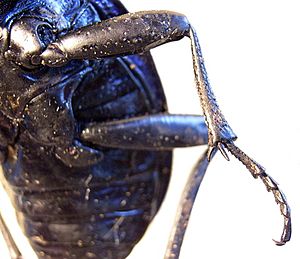Appendage facts for kids
Appendages are parts of an animal's body that are attached to its main body. Think of them like arms, legs, or antennae. They help animals move, feel, eat, and do many other important things.
Many creatures, especially arthropods (like insects, spiders, and crabs), have appendages on most of their body segments. A segment is like a section of their body.
- For example, millipedes have many body segments, and almost all of them have two legs.
- Insects, on the other hand, always have six legs. These legs are attached to the middle part of their body called the thorax.
- Antennae, which are like feelers on an animal's head, are also a type of appendage.
Contents
What Are Appendages Used For?
Appendages come in many shapes and sizes, and they have different jobs.
- Legs help animals walk, run, or jump.
- Wings allow animals like birds and insects to fly.
- Mouthparts are special appendages around the mouth that help animals eat.
- Some appendages are even used for reproduction.
Types of Appendages
Appendages can be grouped into two main types based on their structure:
Uniramous Appendages
A uniramous appendage is simple, like a single branch. It has one main part made of several smaller sections joined together.
- Example: The legs of insects and centipedes are uniramous. They are straight and do not split into two main branches.
Biramous Appendages
A biramous appendage is more complex. It branches into two main sections, like a fork in a road.
- Example: Many crustaceans, such as crabs and lobsters, have biramous appendages. Their legs might split into two parts.
How Appendages Develop
Even though arthropod appendages look very different, they all come from the same basic body plan. Scientists call this homologous, meaning they share a common origin.
The way an appendage grows and what it becomes is controlled by special genes called Hox genes. These genes are like blueprints that tell the body which parts to grow and where. Scientists have even been able to change these genes in animals like the fruit fly (Drosophila melanogaster). This has led to amazing results, like flies growing legs where their antennae should be!
See also
 In Spanish: Apéndice (invertebrados) para niños
In Spanish: Apéndice (invertebrados) para niños


